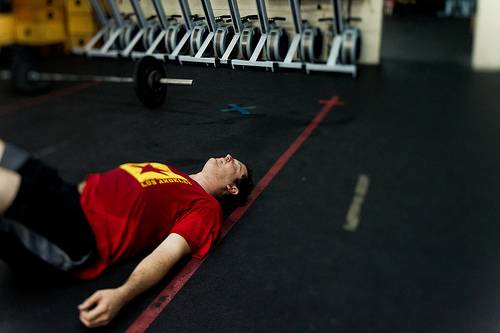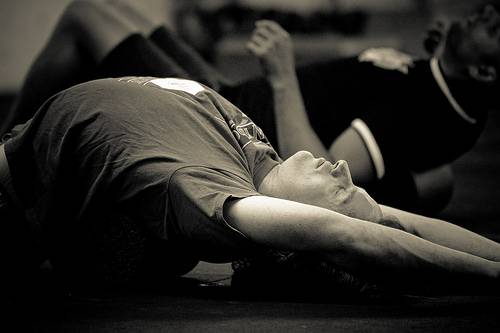“One More!”
“It’s all you bro!”
“Light weight! Light weight!”
Yea, we’ve all been there. The two dudes in their cut-off high school football shirts, screaming to squeeze out one more bench press or finish one final deadlift. That’s probably been you. I’ve been there, so I can’t judge either.
“One More!”
“It’s all you bro!”
“Light weight! Light weight!”
Yea, we’ve all been there. The two dudes in their cut-off high school football shirts, screaming to squeeze out one more bench press or finish one final deadlift. That’s probably been you. I’ve been there, so I can’t judge either.
While these characters may be the brunt of gym jokes, they do have something right. Rather than gliding along on the elliptical, or performing one-foot blindfolded Bosu curls, they are pushing their bodies to the max. Stimulation is the first step to improving performance and building a badass body. The second phase is equally vital: adaptation. With no adaptation no gains can be made, while too much stimulus will lead to overtraining.
Until this week you’ve been building power, adding slabs of muscle, and hitting personal records in the gym. Now, you’re fried. Progress has stalled. Warm-up sets feel like a piano on your back, and motivation is fading. In fact, you’d rather try a Tracey Anderson workout than lift another barbell. What gives?
How Adaptation Works
To address the problem we look to the General Adaptation Syndrome (GAS) by Hans Seyle to analyze how changes in performance actually happen. GAS states that the body goes through a specific set of responses (short term) and adaptations (longer term) after being exposed by an external stressor. The theory holds that the body goes through three stages, two that contribute to survival and a third that involves a failure to adapt to the stressor.
According to Practical Programming for Strength Training by Mark Rippetoe and Lon Kilgore, here are the stages of GAS and their relation to training:
Stage 1: Alarm or shock. Alarm or shock is the immediate response to stress and can include feeling flat, soreness, and stiffness. A slight reduction in performance occurs at this phase. The more advanced the athlete, the greater the stress needed to induce the shock phase.
Stage 2: Adaptation or resistance. Adaptation occurs as the body responds to the training and attempts to equip itself with the tools to survive exposures to stress. In training this can include hormonal adaptations, nervous system adaptations, and tissue building. Adaptation is unique to each individual and varies due to training age and work tolerance in proximity to the genetic ceiling. A gym newbie may recover from this quickly – within 24 hours – while an advanced trainee may require months to disrupt homeostasis and adapt to higher training levels.
Stage 3: Exhaustion. Simply put, this is overtraining. This occurs when the stimulus is too great for the body to adapt. This is most applicable to moderate-to-advanced athletes, and signals that excessive high magnitude, frequency, and duration exercise should be avoided.
To achieve performance gains, stress from training must be enough to disrupt homeostasis, but not too intense to overwhelm the body. Once sufficient stress is applied, recovery comes in to drive progress.
The Role of Recovery
Exercise causes muscular damage, joint stress, soreness, hormone disruption, and neural stress from which we must recover. Most trainees hit training hard and pass the novice phase quickly, but they neglect the fact that recovering from exercise is where gains are made. As athletes become more advanced, training programs must be analyzed and reprogrammed for maximal gains.

Enter the deload. A deload week is simply a back-off week. A week of lower volume, intensity, or both that becomes vital for training. Deload weeks provide ample time to recover from the stress of weeks prior, to repair joints and tendons, to allow hormone ratios to optimize, and to keep you mentally sharp. Basically, a deload rewards your efforts and makes you more awesome.
How to Deload
Deload frequency varies depending on the athlete, training age, goals, sports requirements, and number of workouts per week. Here is a sample micro-cycle with a built in deload. Volumes and intensities are for a compound exercise, such as a power clean and for the moderate-to-advanced athlete.
- Week 1: High Intensity/Low-Moderate Volume, 4×3, 85-92.5% 1RM
- Week 2: Moderate Intensity/Moderate-High Volume, 5×5, 75-85% 1RM
- Week 3: Very High Intensity/Low Volume, 4×3, then 2,2,1,
- 85-100% 1RM
- Week 4: Low Intensity/Low-Moderate Volume, 3×5, 50-60% 1RM
With more advanced athletes, I may flip weeks one and two, and three and four, for better performance benefits during the highest intensity workouts.
- Week 1: Moderate Intensity/Moderate-High Volume, 5×5, 75-85% 1RM
- Week 2: High Intensity/Low-Moderate Volume, 4×3, 85-92.5% 1RM
- Week 3: Low Intensity/Low-Moderate Volume, 3×5, 50-60% 1RM
- Week 4: Very High Intensity/Low Volume, 4×3, then 2,2,1, 85-100% 1RM
There is an inverse relationship between intensity (1RM) and the number of reps per set. Training in both manners, if you can even do it, is a recipe for overtraining. For this reason, varying intensity and volume through workouts is ideal to allow recovery and maximal effort.
On deload weeks, training is still performed in an effort to preserve the neuromuscular pathways of training without actually breaking down the body. This works well for form and speed work to preserve form and muscle mass. Cool, eh? That means yes, you can still do your glorious bench press or deadlifts on deload weeks, just not heavy.
How to Incorporate Deloading Into Training
Deload weeks are simple. Just back things off every few weeks of training. I recommend the three-on-one-off and five-on-one-off cycles for athletes. Work out on consistent days to maintain a schedule during the deload, as this also helps maintain focus.
Schedule your deload weeks in advance and stick to the routine. When the time comes, have a plan of action. Focus on your important movement patterns combined with engaging low-intensity activities to provide a mental and physical break from training.
Considerations
I don’t suggest a week of complete rest, but rather a week of active recovery. Active recovery workouts are self-explanatory: low intensity activity performed to improve recovery. Submaximal work (<65%), mobility exercises, stretching, soft-tissue methods, and even light aerobic exercise apply here.

During a seven-day deload, aim for three or four complete rest days and three or four active recovery session. Listen to the body. That’s the whole point. If you feel stale after the warm up and main lift, it’s fine to pack it in, hit some light active recovery, and end the session.
Nutrition
Don’t start eating Pizza Hut and Taco Bell every night because your training is tapered back, but don’t eat like a bird either. A piss-poor diet does nothing for you unless you’re trying to grow a spare tire or fail at your goal. A lower training stimulus provides more recovery resources to the body, and by resources I mean the awesome nutrition program you’ve been following will boost your recovery. Remember, it’s repair time. It’s essential to provide the body with fuel to complete the repair. Recovery is not just the absence of training. Recovery is the combination of rest, nutrition, and care for your body.
Wrap Up
Deload weeks are a necessary component for looking good naked, maximizing performance, and long-term training. A focus on recovery will decrease incidence of injury, increased physical performance, and increase motivation for subsequent training. After a week in low gear, you will be primed and ready to shift training into overdrive for upcoming sessions and achieve maximum benefit.
References:
1. Rippetoe, Mark, and Lon Kilgore. Practical Programming for Strength Training. Wichita Falls TX : The Aasgaard Company; 2nd edition , 2009.






